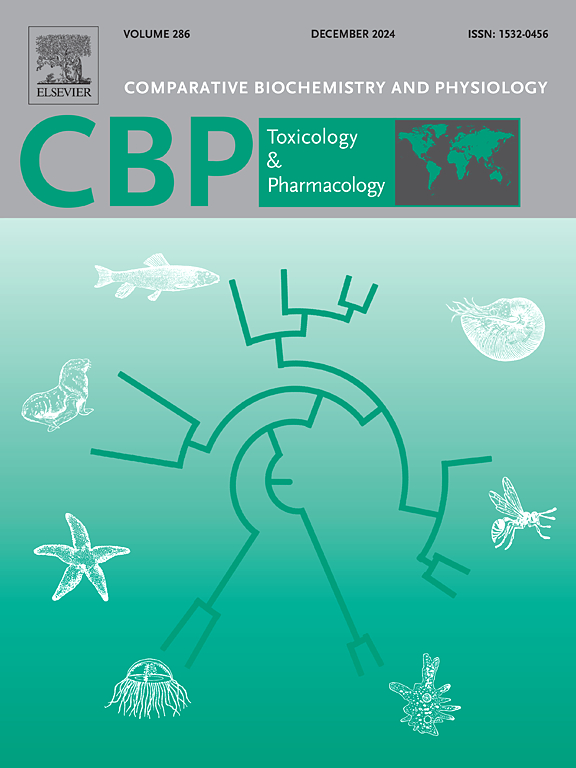Effects of in vitro cytochalasin D and hypoxia on mitochondrial energetics and biogenesis, cell signal status and actin/tubulin/Hsp/MMP entity in air-breathing fish heart
IF 3.9
3区 环境科学与生态学
Q2 BIOCHEMISTRY & MOLECULAR BIOLOGY
Comparative Biochemistry and Physiology C-toxicology & Pharmacology
Pub Date : 2025-01-27
DOI:10.1016/j.cbpc.2025.110132
引用次数: 0
Abstract
The cardiac actin cytoskeleton has a dynamic pattern of polymerisation. It is uncertain how far actin destabilisation impacts mitochondrial energetics and biogenesis, cell signal status, and structural entities in cardiomyocytes, particularly in hypoxic conditions. We thus tested the in vitro action of cytochalasin D (Cyt D), an inhibitor of actin polymerisation, in hypoxic ventricular explants to elucidate the role of the actin in mitochondrial energetics and biogenesis, cell signals and actin/tubulin/hsps/MMPs dynamics in hypoxic air-breathing fish hearts. The COX activity increased upon Cyt D exposure, whereas hypoxia lowered COX and SDH activities but increased LDH activity. The ROS increased, and NO decreased by Cyt D. COX and LDH activities, and NO content reversed after Cyt D exposure in hypoxic hearts. Cyt D exposure upregulated actin isoform expression (Actc1 and Actb1) but downregulated tubulin isoform (Tedc1). Hypoxia upregulated actin (Acta1a, Actb1, Actb2, Actc1a) tubulin (Tuba, Tubb5, Tedc1, Tubd1) and hsp (Hspa5, Hspa9, Hspa12a, Hspa14, Hspd1, Hsp90) isoform transcript expression and Cyt D in hypoxic hearts reversed these isoform's expression. Hypoxia upregulated Mmp2 and 9 transcript expressions but downregulated Mfn1, Fis1, Nfkb1, Prkacaa, and Aktip expressions, and Cyt D exposure reversed almost all these markers in hypoxic hearts. The data provide novel evidence for the mechanistic role of actin in integrating mitochondrial energetics and biogenesis, cell signal status and actin/tubulin/Hsp/MMP entity, indicating its critical cardioprotective role in defending against hypoxia. Besides proposing an air-breathing fish heart as a model, the study further brings the therapeutic potential of Cyt D towards hypoxia intervention.

体外细胞松弛素D和缺氧对呼吸鱼心脏线粒体能量学和生物发生、细胞信号状态和肌动蛋白/微管蛋白/Hsp/MMP实体的影响
心肌肌动蛋白细胞骨架具有动态聚合模式。目前还不确定肌动蛋白不稳定对线粒体能量和生物发生、细胞信号状态和心肌细胞结构实体的影响程度,特别是在缺氧条件下。因此,我们测试了细胞松弛素D(一种肌动蛋白聚合抑制剂)在缺氧心室外植体中的体外作用,以阐明肌动蛋白在缺氧呼吸鱼心脏中线粒体能量和生物发生、细胞信号和肌动蛋白/微管蛋白/hsps/MMPs动力学中的作用。暴露于Cyt D后,COX活性升高,而缺氧降低了COX和SDH活性,但增加了LDH活性。低氧心脏暴露Cyt D后,ROS升高,NO降低,COX和LDH活性降低,NO含量逆转。Cyt D暴露上调肌动蛋白异构体表达(Actc1和Actb1),但下调微管蛋白异构体表达(Tedc1)。缺氧可上调肌动蛋白(act1a, Actb1, Actb2, Actc1a)微管蛋白(Tuba, Tubb5, Tedc1, Tubd1)和hsp (Hspa5, Hspa9, Hspa12a, Hspa14, Hspd1, Hsp90)异构体转录本的表达,而在缺氧心脏中,Cyt D可逆转这些异构体的表达。缺氧可上调Mmp2和9转录物的表达,但下调Mfn1、Fis1、Nfkb1、Prkacaa和Aktip的表达,而在缺氧心脏中,Cyt D暴露几乎逆转了所有这些标记物的表达。这些数据为肌动蛋白在整合线粒体能量和生物发生、细胞信号状态和肌动蛋白/微管蛋白/Hsp/MMP实体中的机制作用提供了新的证据,表明其在防御缺氧中具有重要的心脏保护作用。除了提出一种呼吸空气的鱼心脏作为模型外,该研究还进一步揭示了Cyt D在缺氧干预方面的治疗潜力。
本文章由计算机程序翻译,如有差异,请以英文原文为准。
求助全文
约1分钟内获得全文
求助全文
来源期刊
CiteScore
7.50
自引率
5.10%
发文量
206
审稿时长
30 days
期刊介绍:
Part C: Toxicology and Pharmacology. This journal is concerned with chemical and drug action at different levels of organization, biotransformation of xenobiotics, mechanisms of toxicity, including reactive oxygen species and carcinogenesis, endocrine disruptors, natural products chemistry, and signal transduction with a molecular approach to these fields.

 求助内容:
求助内容: 应助结果提醒方式:
应助结果提醒方式:


